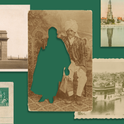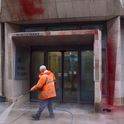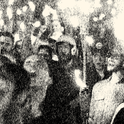The gilets jaunes protests have radicalised in recent days—now, images of police brutality could fan the flames of the movement.
In recent weeks, France has experienced its worst urban riots since 1968. The “yellow vest” (gilets jaunes) movement—named after the high visibility jackets that French drivers are required to have in their cars—has been blocking roads across the country and escalated from being an anti-tax movement into a broader outburst of popular anger against political elites.
On Thursday, footage showing a police roundup of 148 protesting high school students in Mantes-la-Jolie shocked the nation. The video—which appeared to shows the teenagers kneeling, hands behind their heads and policemen ironically observing, “this is a well-behaved class”—has drawn condemnation from most opposition parties and further angered the gilets jaunes, who shared it widely on social media.
The timing of the incident could not have been more unfortunate. Not only did the video emerge two days before planned large-scale protests at the weekend, it also reactivated disturbing historical associations: exactly 32 years before on 6 December 1986, France made international headlines after 22-year-old student Malik Oussekine died after confronting the police during a student demonstration—an incident which turned French public opinion against the then-government.
Such images of humiliation are likely to fan the flames of a movement already in a state of escalation. Since 17 November, the gilets jaunes movement has followed a trajectory of increased radicalisation. After starting as a relatively peaceful protest, it turned violent on 1 December when clashed erupted in Paris, with protesters painting desecrating national monuments, looting luxury shops and torching cars. Casseurs (hooligans) also joined the protests and threw rocks at the police, who retaliated with tear gas.
Further images of police brutality—with protesters releasing more videos showing police forces beating up some gilets jaunes—could make a difficult situation more explosive. Following the disturbing police roundup in Mantes-la-Jolie, students from across the country recreated the arrest scene in solidarity with their arrested peers, a gesture likely to become a symbol of youth mobilisation.
While the majority of gilets jaunes are shunning violence and many have condemned last week's scenes of violence, the movement's amorphous nature—it is officially leaderless and has no real coordination, top command or political line—has left it vulnerable to attempts at political and ideological recuperations by extreme factions, and to the radicalisation of its most active core members.
From the early days of the movement, reports emerged of the movement's infiltration by far-right and far-left activists. Several far-right fringe groups including Action francaise and Bastion social prompted their supporters to take to the streets. Last weekend, members of the extreme-right student movement Groupe Union Defense (GUD) joined the protests and painted graffitis on shops and public buildings. A violent minority, these fringe groups do not reflect the gilets jaunes as a whole.
More concerning, however, has been the radicalisation of the wider movement's discourse and tactics. A recent report from the Ministry of the Interior shows the movement's increased use of encrypted messaging and the “normalisation of the use of violence” on social media. Some of the movement's informal leaders have called for bolder action to achieve their goals, despite last weekend's scenes of chaos.
One of them—Eric Drouet—suggested that protesters could "enter the Elysee," while another encouraged his followers to “seize the prefecture” (the local political authorities building) in the central region of Isere.
Calls for more radical action could benefit fringe groups. Some far-right activists are already capitalising on the hardening of the movement's rhetoric and the general insurrection spirit in the country to call their protesters to topple the government and put an end to the constitution. Yvan Benedetti, the former leader of the now dissolved far-right Oeuvre Francaise has multiplied calls for insurrection online. Alexandre Gabriac, a former leader of the Jeunesses Nationalistes (JN), has made similar appeals.
The handling of the protests by police forces will be decisive in shaping what happens next. French authorities are faced with a difficult balancing act between maintaining order and appeasing the movement as protesters vow to continue the fight. On the fourth weekend of protests, authorities have deployed armoured vehicles in Paris. But if the last week is anything to go by, this show of force might not achieve the desired effect.
France's far-right are poised to capitalise on the gilets jaunes—and the police response isn't helping
Images of apparent police brutality are fanning the flames of radicalisation as the movement spreads. As armoured vehicles are deployed in Paris, things could heat up further
December 08, 2018













